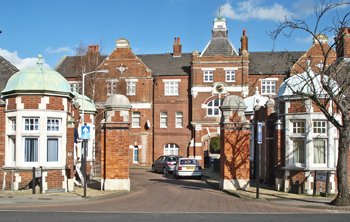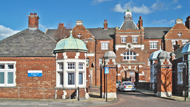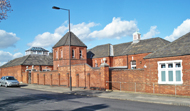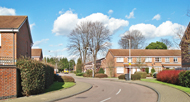Tuberculosis. Later, mental handicap
Grove Park Hospital had originally been a workhouse. It was built by the Board of Guardians of the Greenwich Union after they had been refused permission to expand their site at Vanburgh Hill (that workhouse later became Greenwich District Hospital). Instead, Spicers Meadow, a 10-acre site, was purchased in 1896 for £5,050 so that an 'overspill' workhouse could be built. The foundation stone was laid in 1899 and the workhouse completed in 1902, with accommodation for 815 inmates. However, changes in the poor relief system provided more out-relief, with the result that numbers applying for admission to workhouses fell dramatically, and the new workhouse remained empty until 1904. It remained unpopular because of its remote location, but provided the usual work for its able-bodied inmates - breaking up granite which was later sold to councils for road building.
At the beginning of WW1 in 1914 the workhouse was requisitioned by the Army Service Corps. Its occupants were relocated and the buildings were used as a mobilisation training camp.
In 1919 the workhouse was sold to the Metropolitan Asylums Board (MAB) for use as a hospital for TB patients living in south London. But the site's remoteness made staff recruitment difficult and MAB soon decided not to use it. The buildings remained empty until 1926, when they were finally adapted, at a cost of £38,000, as a hospice for TB patients. The workhouse was renamed Grove Park Hospital. It had 299 beds - 117 for males and 182 for females.
The entrance on Marvels Lane was flanked by single-storey buildings. The central administration block had four 3-storey pavilions on either side. Female patients were housed on the south side, and males on the north. All the buildings were linked by covered walkways. The workshops and utilities were located at the northeast of the site.
In 1930 the Hospital came under the control of the LCC, who built a Nurses' Home in 1938.
During WW2, in November 1940, the Hospital was damaged by a high explosive bomb. Two nurses, Mary Fleming and Aileen Turner, crawled through one of the upper windows and across the swaying floor of a ward to reach trapped patients. The floor collapsed a few minutes after the rescue. Both nurses were awarded the George Medal.
By 1945 the Hospital had become a centre for thoracic surgery. It joined the NHS in 1948 under the control of the Lewisham Group, part of the South East Metropolitan Regional Hospital Board. It had 393 beds for TB and chest cases. The average stay for a patient was 141 days.
In 1952 a new Recreation Hall for the patients opened. It had cost £6,000.
In December 1957 a train crash occurred just outside St John's railway station. The casualties were taken to Lewisham Hospital, St John's Hospital and Grove Park. Ninety two people were killed and 173 injured.
In 1968 a geriatric ward with 30 beds was opened.
In 1974 the Hospital had 316 beds.
It remained a TB and chest hospital until 1977, when it was redesignated as a facility for mentally handicapped patients. It had 168 beds but, as patients were resettled in the community, it had only 62 beds by 1978.
The Hospital closed in 1994 as part of the Regional Health Authority's hospital closure programme.
Present status (February 2008)
The site was sold to contractors in 1992 for housing redevelopment and many of the original buildings, which had not been listed by the Greenwich or Lewisham authorities, were demolished. However, some of the workhouse buildings along Marvels Lane survive.
The new road around the former main administration block is named after the architect who designed it - Thomas Dinwiddy Road.

The main entrance to the former Hospital. The lodges and the main administration building have survived.

Marvels Lane clinic is to the left of the main entrance.


The former 1-storey Hospital buildings along Marvels Lane, on either side of the main entrance, have also survived.


Looking east towards the site.

New housing along Edward Tyler Road.
(Author unstated) 1941 Honour for nurses. British Journal of Nursing, May, 74.
(Author unstated) 1998 A Rich Past...An Exciting Future. London, The Lewisham Hospital NHS Trust.
Chaplin R, Peters S 2003 Executives have taken over the asylum: the fate of 71 psychiatric hospitals. Psychiatric Bulletin 27, 227-229.
www.aim25.ac.uk
www.greenchain.com
www.ideal-homes.org.uk
www.lewisham.gov.uk
www.lewisham.nhs.uk
www.workhouses.org.uk
www2.lewisham.gov.uk
Return to home page